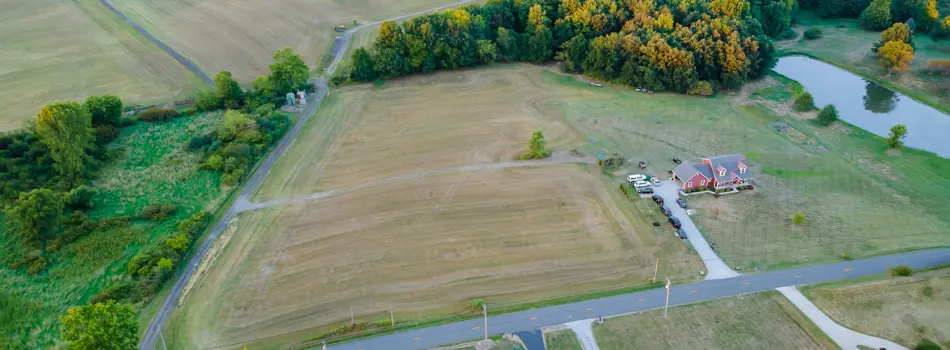Who Qualifies For A USDA Rural Home Loan
September 12, 2023
Like some other government entities, the USDA backs certain loans made to eligible borrowers.
USDA single family rural development home loans are actually among the easier types of subsidized loans to qualify for, but they still have specific requirements. These loans are intended for borrowers with a moderate level of income who want to purchase an existing home or build on rural land.
USDA Single Family Home Loan Eligibility
USDA single family rural development home loans finance plots of land on the condition that the borrower intends to build a home on the land to use as their primary residence. As such, a number of the requirements one will need to meet when applying for this type of loan revolves around that concept.
Land requirements
First, USDA loans are only available in certain eligible areas - typically rural locations. Additionally, the plot of land can be no larger than the average size of other properties in the area. This is because USDA-backed financing is reserved for those who truly benefit from it. As such, if you’re hoping to finance a plot of land that would be considered luxurious, you probably won’t qualify for this type of loan.
Plans to build a home
As previously mentioned, you will need to have plans to build a home on the land. You must either have plans in place already or otherwise begin construction within a short timeframe and there will be a deadline for completion.
Construction on the home must be completed within 180 days of purchasing the land. If you don’t think your project can be completed within this timeframe, a different type of mortgage may be your best bet.
Applicants can also plan to buy a qualifying existing home, including the costs of rehabilitating, improving, or relocating the dwelling.
Talk to a First Bank & Trust Mortgage Banker to find out which type of loan is right for you.
Income limits
In addition to land and home building requirements, you’ll also need to qualify in terms of income.
USDA loans are designed to help those with low to modest levels of income, so you can actually be disqualified by earning too much.
Borrowers must demonstrate stable and dependable income for repayment qualification. Minimum income history requirements depend on the source of income.
Note that this income includes all adults in your household. If others in your household over the age of 18 are earning any income, their income will be added to yours when determining your eligibility - so keep this in mind. If your income is higher than the local average, you aren’t someone who qualifies for a USDA home loan. The good news is if that’s the case, you are likely to qualify for other financing options and still build the home of your dreams.
Credit and DTI ratio
As with any type of loan, consideration when qualifying for a USDA home loan involves your ability to make payments.
To determine this, your First Bank and Trust lender will look at factors including your credit score and debt-to-income (DTI) ratio. In general, your credit score should be at least 640.
Some lenders may be more lenient on this requirement, but your credit history should be solid enough to indicate that you are a low-risk borrower.
As for your DTI ratio, your level of debt shouldn’t be more than 29% of your gross income. This limit may be a bit higher depending on your circumstances and the size of the loan, with the maximum limit being 46% (including the loan and previous debts), but the lower your DTI ratio, the better off you’ll be.
If you aren’t sure where you stand, it doesn’t hurt to get in touch with one of our mortgage experts to look at your current financial situation before starting the loan application. They will be able to give you an idea of what you can reasonably expect, and offer any suggestions to get your approved.
USDA Rural Development Home Loan Approval Process
The application and approval process function much like other loans, though your loan officer will pay special attention to the requirements set forth above.
To be approved, you’ll have to go through the process described below.
- Fill out a loan application - As with any loan, you begin by filling out a loan application. The application will ask you to state the purpose of the loan as well as the amount you wish to borrow.
Take note: that amount is based on the improved value of the land once you’ve built your home, not the original value. As for the purpose, just note you are borrowing the loan in order to buy land to build a home.
Again, without the intention to build a home, or without a qualifying existing dwelling, you won’t be approved for a USDA loan, so this part is important. - Credit check - Once you complete your application, your loan officer will conduct a credit check. They’ll look up your credit score and determine whether you meet the USDA’s minimum requirement of 640. Some lenders will let you borrow at a score of 620, but any amount below that will subject you to a higher level of scrutiny. If your credit score is below 620, it may be worthwhile to take some time to build up your credit.
Even if you don’t reach the threshold, having a healthy credit history for the last 12 months could help your chances of being approved. - Proof of assets and income - After the credit check, you’ll need to provide proof of your income and assets. This will usually include the following documents: Your last two pay stubs, two years’ worth of W-2 forms and any asset statements that may be applicable.
Asset statements are typically required if you want to pay the closing costs of the loan yourself instead of including them in the financing. - Details about land - Finally, you’ll need to supply details about the land you intend to purchase.
These details include the size (above a certain threshold and you won’t qualify) and your intention to build a house on the land.
Meeting USDA Rural Development Home Loan Requirements
If you don’t meet the necessary requirements, it’s usually because you either earn too much to qualify or don’t earn enough to meet the DTI requirements.
Your credit might also be an issue, in which case working to improve it can help you qualify. If your current level of debt is a bit high, taking steps to reduce it will help as well.
Overall, a USDA home loan is useful in that it doesn’t have the same seasoning requirements that other government-backed loans often have, and it’s relatively easy to qualify if you have a moderate level of income.
Learn more about USDA home loans from First Bank & Trust - serving Virginia, Tennessee and North Carolina for more than 40 years.
Original Publish Date: August 17, 2019
Article Revised: September 12, 2023




